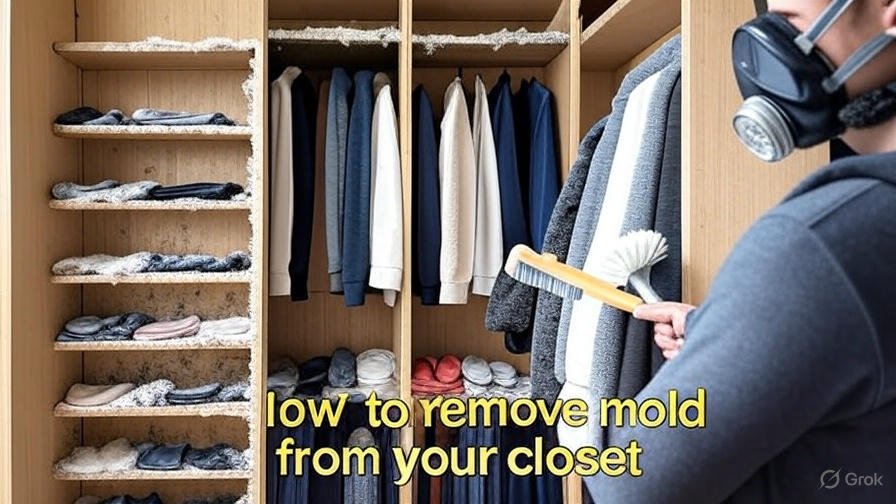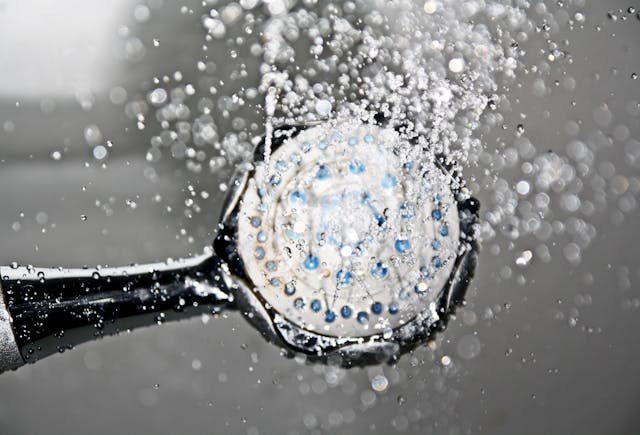Opening your closet only to discover a musty smell or visible patches of mold can be frustrating and unsettling. Mold thrives in dark, humid spaces, making closets particularly vulnerable. Left untreated, it doesn’t just ruin clothing and shoes, but it can also spread to walls, fabrics, and other belongings while negatively impacting the air quality in your home.
The good news? Mold in closets can be removed safely and effectively, whether you’re dealing with light mildew or more serious mold infestations. This guide will walk you through the causes, signs, DIY solutions, professional options, and prevention strategies to ensure your storage spaces stay clean and mold-free.

What Causes Mold in Closets?
Closets are an ideal breeding ground for mold due to their dark, confined nature. Here are some key factors that contribute to mold growth in closet spaces:
- Humidity and Moisture
Elevated humidity levels, especially in closets close to bathrooms, kitchens, or laundry areas, can create the moisture that mold needs to thrive. - Poor Ventilation
Most closets lack adequate airflow, trapping damp air inside and preventing moisture from evaporating. - Leaking or Damp Walls
If your closet is adjacent to a wall with water damage, the moisture can seep in and provide a perfect environment for mold spores. - Storage of Damp Items
Placing damp shoes, clothes, or bags inside your closet introduces moisture directly into the space, fueling mold growth. - Clutter
An overstuffed closet can block air circulation, creating pockets of stagnant, moisture-laden air in which mold thrives.
By understanding these causes, you can identify vulnerabilities and take steps to prevent future mold infestations.
Signs of Mold in Closets
Identifying mold in its early stages is key to removing it effectively. Here are some signs that mold is present in your closet:
- Musty Smell
A persistent earthy or musty odor is one of the first indications of mold growth. - Visible Mold Spots
Black, green, white, or orange patches on walls, wooden surfaces, or clothes in your closet are clear signs of mold. - Discolored Clothing or Fabrics
Mold can create stains or degrade the fibers in stored fabrics and clothing. - Warped or Soft Wooden Surfaces
Closet shelves, walls, or floors that feel soft, look warped, or show water damage are often linked to mold infestations. - Allergy Symptoms
If you experience sneezing, itchy eyes, or other allergy-like symptoms that worsen when opening your closet, mold spores could be the culprit.
Regularly inspecting your closets for these signs can help you catch mold early and address it promptly.
Tools and Materials Needed for Mold Removal
To safely and effectively remove mold from your closet, gather the following tools and materials:
Protective Gear
- N95 mask or respirator (to avoid inhaling mold spores)
- Rubber or latex gloves
- Safety goggles
Cleaning Agents
- White vinegar (a natural, mold-killing solution)
- Baking soda
- Hydrogen peroxide (effective for tougher stains)
- Mild detergent
- Bleach solution (1 part bleach to 10 parts water, for nonporous surfaces only)
Cleaning Tools
- Spray bottle (for cleaning liquids)
- Scrubbing brush (soft or medium-bristle)
- Microfiber cloths or sponges
- Bucket of clean water
Drying Materials
- Absorbent paper towels
- Dehumidifier or fan
- Silica gel packets
These items will make the mold removal process easier and safer while ensuring thorough cleaning.
Step-by-Step Guide to Remove Mold from Closet Safely
Step 1: Empty the Closet
Start by removing everything from the closet, including clothes, shoes, and storage boxes. Inspect each item for mold and set aside anything that requires cleaning or disposal.
Step 2: Wear Protective Gear
Wear a mask, gloves, and goggles to protect yourself from mold spores, which can trigger allergies or respiratory issues.
Step 3: Prepare a Cleaning Solution
Choose a suitable mold-removal solution based on the affected materials:
- Use white vinegar or hydrogen peroxide for wooden surfaces or walls.
- Add a few tablespoons of baking soda to the mixture for additional scrubbing power.
- Stick to mild detergent for treating mold on fabrics or soft surfaces.
Pour your chosen solution into a spray bottle for easy application.
Step 4: Clean Affected Surfaces
- Spray the cleaning solution generously onto moldy areas. Allow it to sit for 10–20 minutes to break down spores.
- Scrub lightly with a brush or microfiber cloth to remove the mold. Avoid scrubbing too hard, as this can damage walls, wood, or paint.
- Wipe down surfaces with a clean, damp cloth to remove residue.
Step 5: Treat and Clean Fabric Items
For clothes, linens, and soft items:
- Launder washable items in hot water with detergent and a cup of white vinegar.
- Dry-clean items labeled as such and inform the cleaners about possible mold.
- Discard heavily moldy fabrics that can’t be salvaged or safely cleaned.
Dry all items thoroughly before placing them back in the closet.
Step 6: Dry and Ventilate the Closet
- Use a dehumidifier or fan to dry the space completely. Open the door and nearby windows to improve airflow.
- Leave silica gel packets or moisture absorbers in the closet to keep it dry.
Step 7: Inspect and Repeat
Examine the closet to ensure all mold has been removed. Repeat the cleaning process for any remaining spots or stains.
Professional Mold Removal Options
For severe or recurring mold problems, professional services can provide a comprehensive solution. Here’s why you might consider hiring trained experts:
- Advanced Equipment
Professionals have specialized tools like HEPA vacuums and infrared moisture detectors to clean mold and identify hidden issues. - Thorough Mold Removal
Mold remediation services ensure that both visible and hidden mold are eliminated for good. - Structural Repairs
Professionals can fix water damage or insulation issues contributing to mold growth.
While DIY techniques work for minor cases, professional help may be necessary for extensive mold infestations or structural damage.
Tips for Preventing Mold in Your Closet
Once you’ve cleared your closet of mold, take these preventive measures to keep it from returning:
- Control Humidity
Maintain indoor humidity levels below 50%. Use a dehumidifier in damp climates. - Improve Ventilation
Install louvered doors or add vents to closets to allow better airflow. - Address Water Damage Promptly
Fix leaky pipes, walls, or ceilings near the closet to prevent moisture buildup. - Don’t Store Damp Items
Only place completely dry clothes, shoes, or bags in your closet. - Clean and Declutter Regularly
Wipe down surfaces and rotate stored items every few months to prevent moisture from being trapped. - Use Moisture Absorbers
Place silica gel packets or activated charcoal in the closet to absorb excess moisture.
By developing these habits, you can protect your closet and stored items from future mold problems.
When to Replace Closet Materials
Sometimes, mold may cause irreversible damage to your closet walls, shelves, or flooring. Here’s when you may need to consider replacement:
- Extensive Staining or Warping
Wooden shelves, doors, or drywall that are warped or stained beyond repair should be replaced. - Recurrence of Mold After Cleaning
Persistent mold suggests underlying issues, such as water damage, which may require structural repair or replacement. - Deterioration of Fabrics
Severely mold-damaged clothes or textiles may need to be discarded or replaced.
Consult a contractor for closet repairs if structural damage is extensive.
FAQs About Mold Removal from Closets
Can I prevent mold in a closet with no windows?
Yes. Use dehumidifiers, louvered doors, and moisture absorbers to reduce humidity and improve airflow.
Is bleach a good choice for removing mold in closets?
Bleach can work for nonporous surfaces like metal shelves but is less effective on porous ones, such as wood or drywall.
How do I clean mold off leather items in my closet?
Wipe them with a cloth dipped in a solution of vinegar and water, then dry thoroughly. Use a leather conditioner afterward.
Can mold in closets spread to other parts of the house?
Yes, mold spores are airborne and can spread if not addressed promptly.
How often should I inspect my closets for mold?
Inspect closets seasonally and during periods of high humidity to catch mold early.
Conclusion
Removing mold from your closet might seem like a daunting task, but with the right tools, methods, and preventive measures, you can effectively eliminate the problem and protect your stored items. Whether you’re tackling DIY solutions or seeking professional help for tougher cases, the key is to act quickly and prevent moisture from taking hold in the future.
Keep your closet clean, dry, and clutter-free to stop mold in its tracks. Consistent maintenance will ensure your storage spaces remain fresh, safe, and mold-free for the long haul. Don’t wait for the problem to worsen; start restoring your closet today!

Anamika is a passionate writer for Eco365Store.com, specializing in topics that inspire a cleaner, greener world. With expertise in home cleaning, recycling, and eco-friendly solutions, she crafts engaging and informative articles that help readers adopt sustainable practices in their daily lives.

